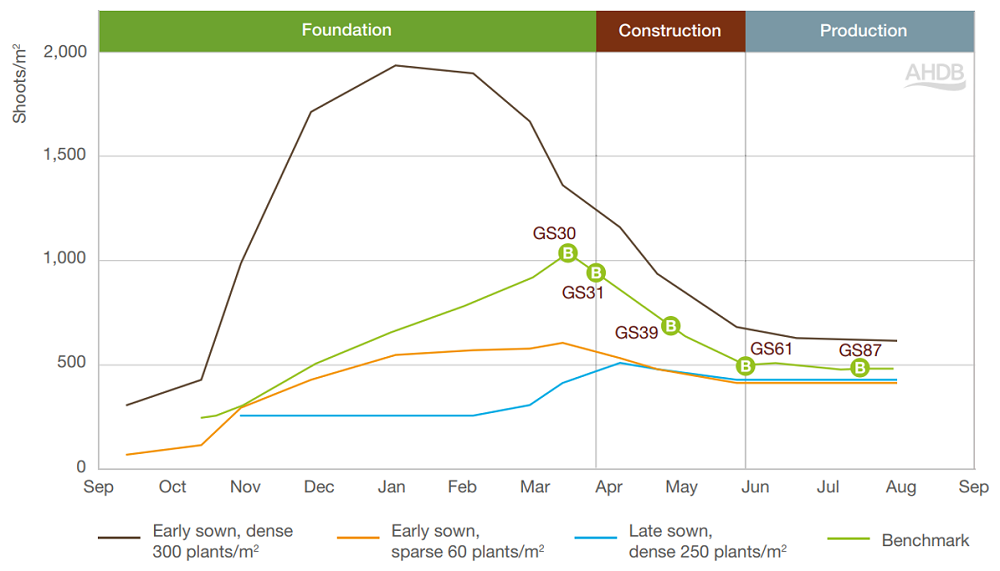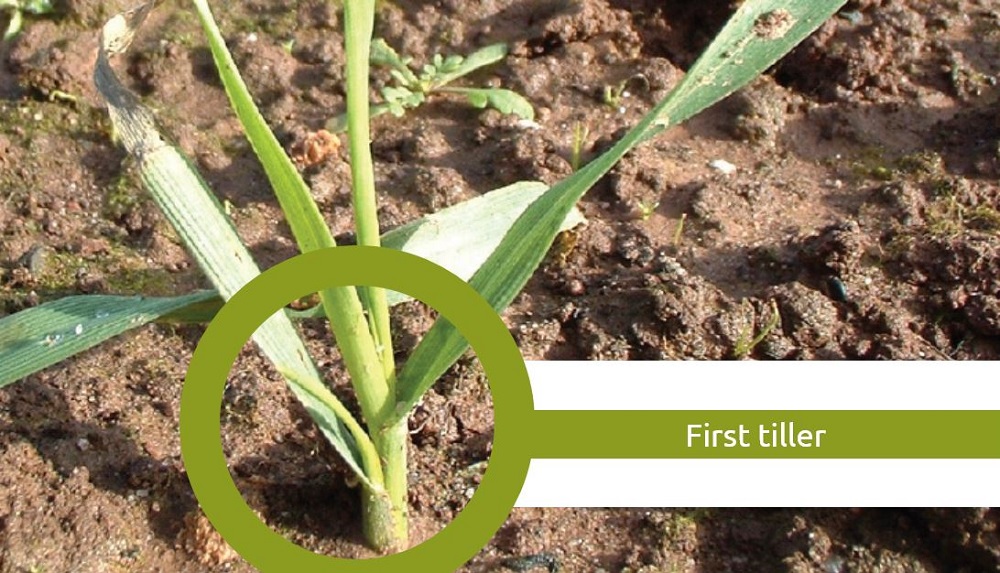- Home
- Knowledge library
- Leaf emergence and tillering growth stages in winter wheat (GS1–GS2)
Leaf emergence and tillering growth stages in winter wheat (GS1–GS2)
The production of leaves and tillers (side shoots) is an essential part of canopy development. Careful management is needed to optimise and protect these structures to help maximise potential wheat yields.
Establishment in wheat: germination and emergence (GS0–GS2)
Growth guides for wheat, barley and oilseed rape
Key facts about leaf emergence and tillering
- Rate of leaf emergence is controlled mainly by temperature
- Leaf emergence, together with disease risk, determine spray timings
- Each main shoot produces nine to 14 leaves, of which five to seven are on the extended stem
- At least 400 fertile shoots (ears)/m2 are required for maximum yield
- All varieties can produce many tillers
- Early sowing and fertile soils increase tillering
- Tillering is prolonged at low plant populations
- Many tillers die between growth stage 31 (start of stem extension) and 61 (flowering)
- High nitrogen (N) supplies encourage tiller survival
- Tillering is the most important process governing canopy formation
How to measure leaf emergence (phyllochron)
Benchmark: 122ºC days/leaf (14 main shoot leaves)
Varietal influence: Low
Other influences: Sowing date
A phyllochron is the time period – measured in thermal time (ºC days above a base temperature of 0ºC) – between the emergence of two successive leaves.
Late sowing decreases both phyllochron and total leaves emerged – e.g. early September drilling may give 15 leaves, while November drilling may give nine leaves.
To measure the phyllochron, tag the youngest, fully emerged leaf when plants have three fully emerged leaves, and again when they have seven fully emerged leaves. At the same time, note the proportion emerged of the next partially emerged leaf, as well as the date of tagging.
Monitor tagged plants at growth stage 39 (flag leaf blade just visible) and count the number of leaves that have emerged since the last tag was attached.
Use daily temperature data to calculate the thermal time taken for each leaf to emerge.
Leaf emergence slows or stops in winter and progressively speeds up as temperatures rise in spring.
Factors that affect tiller production
Benchmark: Maximum 35 shoots/plant for October-drilled crop
Benchmark: 1,020 shoots/m2 (8 April, GS30–31) for a late September to early October-sown crop with 260 plants/m2
Varietal influence: Low
Other influences: Sowing date, plant number, N supply
Tillering is the emergence of side shoots at leaf stem junctions.
The first tiller emerges in the junction of the first leaf (or coleoptile) as the second, third or fourth leaves emerge.
The next tiller develops in the second leaf junction one phyllochron later, and so on.
Secondary tillers develop in leaf junctions of primary tillers.
Well-spaced plants can produce fertile tillers until stem extension starts; tillers produced later are rarely fertile.
Tillering normally ends when Green Area Index (GAI) reaches about 1. In dense crops, this usually occurs just before growth stage 31.
Limited resources, especially N, may limit tiller production.
Influence of sowing date on initial shoot number
September to early October sown crops: Plants produce about eight to nine leaves by stem extension and up to 35 shoots on each plant
November-sown crops: Crops may only produce five leaves by stem extension with a potential for 11 or fewer shoots
Higher levels of tillering are associated with widely spaced crops and good growing conditions.
It is usually necessary to establish at least 150 plants/m2 to ensure 400 ears/m2 from an October-sown crop.
The timing of tillering depends on sowing date, plant numbers established and temperature.
 in wheat.PNG)
Early sowing (early September): Most tillering occurs in autumn. If more than 250 plants/m2 are established, then tillering usually ends before winter. If fewer than 100 plants/m2 are established, tillering can continue into spring
Late sowing (November): Tillering is usually delayed until spring unless unusually warm temperatures follow drilling
Early sown crops or crops with many plants/m2 tend to have greater maximum shoot numbers.
Varieties with large leaves or that reach stem extension early tend to have lower maximum shoot numbers.
Influences on final shoot number
Benchmark: 45% (460/m2)
Varietal influence: Medium
Other influences: Shoot number, N supply
Some tillers die between the start of stem extension and flowering, with the last-formed dying first. Few die after flowering. Tiller losses are higher in crops with many shoots.
Shoot survival is as important as shoot production in determining final shoot number. Shoot survival fluctuates significantly between varieties – from under 40% to over 70%. However, all varieties can produce sufficient tillers.
Increasing N reduces tiller loss. Dry matter losses of up to 3 t/ha can occur as shoots die.

How to measure tiller numbers
To measure tiller numbers, follow the same method used to measure plant populations.

Topics:
Sectors:
Tags:

